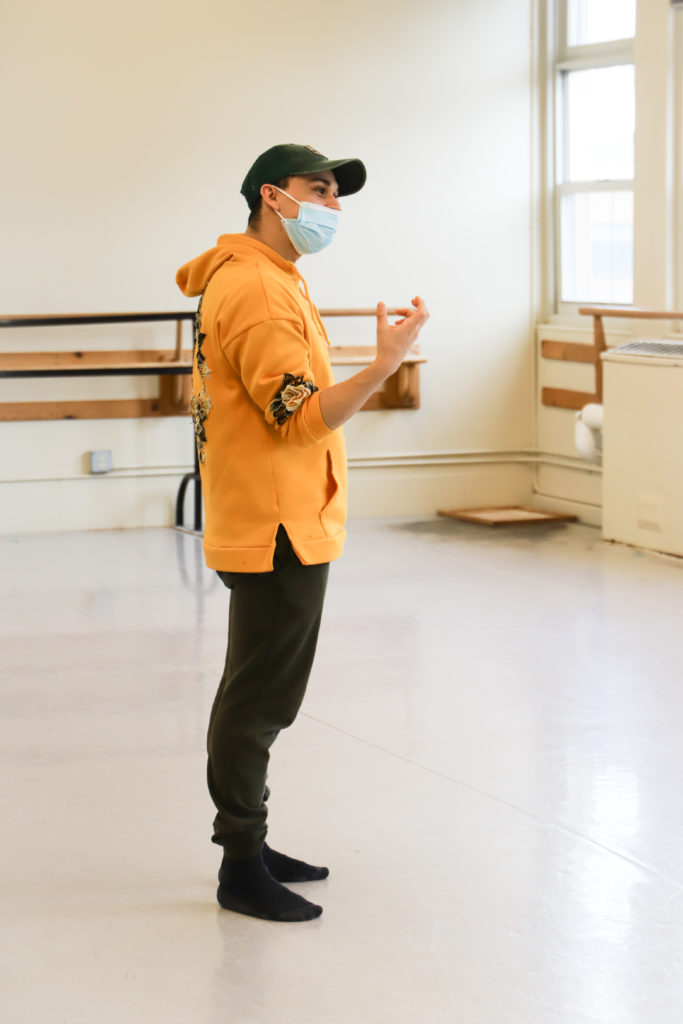Vincent Michael Lopez is a choreographer and a dancer with Spectrum Dance Theater. He choreographed EFANORA, Part 1 of OBT’s Spring Digital Production, filmed for digital release on April 2, 2021.
When did you start dancing?
My uncle and my mother are professional flamenco dancers, and I grew up surrounded by dance. Around my 15th birthday, my uncle had come back from studying flamenco in Spain and gave everybody in the family presents. But to me, he said: “Your gift is special. I will teach you flamenco, if you take one year of ballet classes.”
So, I started taking ballet, and I never stopped dancing. I have yet to learn flamenco, although I am highly influenced by its technique, especially in all my hand gestures.
What made you eventually move from ballet to contemporary dance?
I think of ballet as a “sourdough starter” for dance. Ballet gives you a solid foundation for placement techniques that you can find in many forms of dance. I love training classically and then taking my body to the extreme to see how far away from the classical movement I can go. In a way, contemporary dance is like deconstructing ballet and figuring out how to morph the movement into geometry and shapes.
During my Summer Intensive with ABT in New York, I took a class by Sandra Brown from Complexions Dance Company. Learning the choreography for Red, White, and Blue completely blew my mind. I had no idea dance could do that, and it matched what my body wanted to do naturally. I needed a break from the structure of ballet, and I found a new way to express myself.
What inspired you to create EFANORA?
2020 was a very difficult year, spiritually, emotionally, and physically. There was so much loss, not to mention all the political things that were going on, that it just added an overall heaviness to the world. So, it’s almost like I’ve been cocooning myself the whole year, and this piece expresses all the things I have been feeling.

@intodustphotography
This piece also speaks to my experience with a friend who passed away. We had unresolved issues, and they have moved on, but I am just left here. And there is no resolution. So, I am just carrying all of it until time releases me. It’s a struggle.
What’s in the name EFANORA?
EFANORA is the second part of a two-piece series. The first part, NORAEFA, was premiered in 2017 with six dancers. NORA is Latin word for “light” and EFA comes from a Hebrew derivative of the word “darkness” or “cloaked in darkness.” That piece dealt with six embodiments of all the emotions that were going on in my life at the time: loss, fear, darkness, grace, disease, and light. And in this piece, EFANORA, the dark light just gets darker down the rabbit hole in a nightmarish dream state filled with curiosities, oddities, and loss.
How did you come with the masks that two dancers are wearing in this piece?
I feel like my creative process starts with a visual image. For this piece, I saw an overall image in my mind: the top light and two dancers attached at the mouth with a thread. So, I analyzed what that image meant to me, and the storyline started to emerge.

@intodustphotography
The masks are attached by red threads. Those of us who listen to intuition can almost feel a tethering effect with another human being they love. Clearly, I am one of those people because I feel very much tethered to my husband. If, for example, he is in another room and stressing about something, I can always sense it, so I will come in and ask him what’s wrong, and we will try to talk it through.
What was so different about this experience of choreographing mostly virtually?
It was definitely very different from doing traditional choreography, but I am glad I have developed this new set of skills. I learned to map out everything and use technology for extra help. For example, I can record everybody doing phrases, and then go into an app on my phone, splice them together, put music on top of it, and have this strange experience of what the complete piece could be like.

It also opened up new opportunities because now I can work with dancers regardless of where they are located physically. I can essentially contact another part of the world and say “Hey, I’d love to present this piece. I am virtually capable.”
What do you hope your audience will take away from this piece?
I am asking people to consider the lightness and darkness inside themselves. And I hope they know that it’s okay to feel a certain way, to accept that there is darkness and lightness and not to be afraid to ask for help when needed. We are all here just for a short period of time.
Vincent Michael Lopez is a second-generation choreographer, classically trained, and influenced by his family’s traditional flamenco background. He has also danced and taught Byrd technique for the last 14 years. When creating new works, he often combines all these influences to speak about the human experience from an abstract form of dance.
His choreographic work began at The Ailey School while under the Oprah Winfrey Fellowship Program in 2006. For the next decade and a half, while on stage with companies such as Wideman/Davis Dance, Whim W’Him, and Spectrum Dance Theater, Vincent presented in his off-time choreographic works for The 1st Queer Arts Festival in Spokane, T.U.P.A.C Benefit concert Tacoma, “Murgi Collective” in Dhaka Bangladesh, Homer Alaska Residency, Olympic Ballet School Summer Intensive, and Spectrum Academy. In 2019, he completed a re-work of his 2017 piece “Noreafa” staged on Spectrum Dance Theater.

